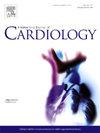Long term prognosis in cardiac sarcoidosis under FDG-PET guided immunosuppressive therapy
IF 3.2
2区 医学
Q2 CARDIAC & CARDIOVASCULAR SYSTEMS
引用次数: 0
Abstract
Background
Cardiac sarcoidosis (CS) is a granulomatous disease that can lead to heart failure and fatal arrhythmias. While 18F-fluorodeoxyglucose–positron emission tomography (FDG–PET) is useful in assessing active inflammation, its role in guiding immunosuppressive therapy and predicting long-term prognosis remains unclear.
Methods
This retrospective study analyzed 36 CS patients who underwent FDG–PET-guided immunosuppressive therapy between 2012 and 2017. FDG uptake was quantitatively evaluated before treatment, at 6 and 12 months, and annually thereafter. Prognostic outcomes, including major adverse cardiac events (MACE) and mortality, were assessed.
Results
Over a median follow-up of 8.2 years, 11 patients experienced MACE, and 7 died. SUVmax at 6 months (six-M SUVmax) and 1 year (one-y SUVmax) significantly correlated with prognosis. Patients with one-y SUVmax >4.5 had a higher risk of adverse events (p < 0.0001), while patients with six-M SUVmax >3.5 had a higher risk of adverse events (p = 0.035). Lower left ventricular ejection fraction (LVEF <40 %) was also associated with worse outcomes. Those requiring a final prednisolone (PSL) dose ≥10 mg had increased mortality (p < 0.0001).
Conclusion
FDG–PET-derived SUVmax at 1 year is a critical prognostic indicator in CS patients undergoing immunosuppressive therapy. Poor response to PSL, indicated by persistent FDG uptake, correlates with worse outcomes. Regular FDG–PET monitoring and personalized treatment strategies are essential to optimizing long-term management.
FDG-PET引导下免疫抑制治疗心脏结节病的远期预后
背景:心脏结节病(CS)是一种肉芽肿性疾病,可导致心力衰竭和致命性心律失常。虽然18f -氟脱氧葡萄糖正电子发射断层扫描(FDG-PET)可用于评估活动性炎症,但其在指导免疫抑制治疗和预测长期预后方面的作用尚不清楚。方法回顾性分析2012年至2017年期间接受fdg - pet引导免疫抑制治疗的36例CS患者。在治疗前、6个月和12个月以及治疗后每年定量评估FDG的摄取情况。评估预后结果,包括主要不良心脏事件(MACE)和死亡率。结果中位随访8.2年,11例患者发生MACE, 7例死亡。6个月SUVmax (6 - m SUVmax)和1年SUVmax (1 -y SUVmax)与预后显著相关。1 -y SUVmax >;4.5的患者发生不良事件的风险更高(p <;0.0001),而6 - m SUVmax >;3.5患者的不良事件风险更高(p = 0.035)。较低的左心室射血分数(LVEF < 40%)也与较差的预后相关。需要强的松龙(PSL)最终剂量≥10mg的患者死亡率增加(p <;0.0001)。结论fdg - pet衍生的1年SUVmax是接受免疫抑制治疗的CS患者的关键预后指标。对PSL的不良反应,表现为持续摄取FDG,与较差的结果相关。定期FDG-PET监测和个性化治疗策略对于优化长期治疗至关重要。
本文章由计算机程序翻译,如有差异,请以英文原文为准。
求助全文
约1分钟内获得全文
求助全文
来源期刊

International journal of cardiology
医学-心血管系统
CiteScore
6.80
自引率
5.70%
发文量
758
审稿时长
44 days
期刊介绍:
The International Journal of Cardiology is devoted to cardiology in the broadest sense. Both basic research and clinical papers can be submitted. The journal serves the interest of both practicing clinicians and researchers.
In addition to original papers, we are launching a range of new manuscript types, including Consensus and Position Papers, Systematic Reviews, Meta-analyses, and Short communications. Case reports are no longer acceptable. Controversial techniques, issues on health policy and social medicine are discussed and serve as useful tools for encouraging debate.
 求助内容:
求助内容: 应助结果提醒方式:
应助结果提醒方式:


